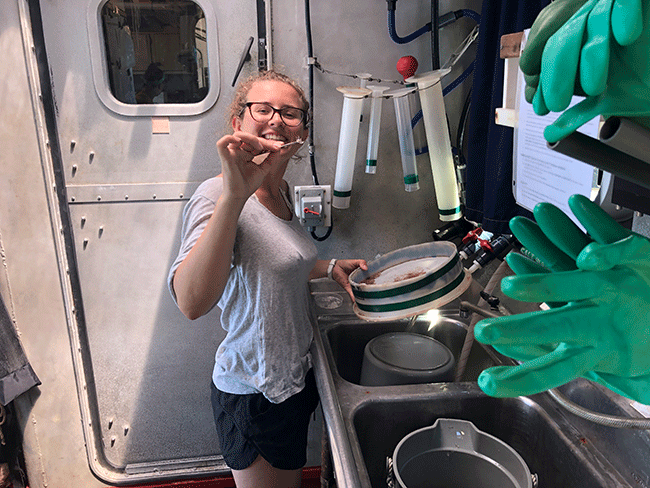Programs Blog
Sampling from the Sea

Allie Cole, Boston University
Ship’s Log
Weather
Calm seas, almost no clouds and a little bit of wind
My day started before the actual first hour of July 12th arrived, I was awake from the morning of the 11th and worked processing net deployments until 03:00 on the 12th (which also happens to be my little brothers birthday!) I spend that time sorting through buckets of zooplankton that the students had pulled up from the three types of net deployments the ship scientists run, a Shallow Tucker Trawl, Deep Trucker Trawl, and a Neuston Tow. Each net deploys to a different depth so we can look at the zooplankton assemblages from multiple levels of the ocean. The Neuston stays at the surface and collects large amounts of Portuguese Man of War Jellyfish, halobates (a type of marine insect similar to water skeeters) and beautiful blue copepods. The tucker trawls go to 50 and 100 meters and we find a larger amount of fun zooplankton and fish larvae.
After I finished sorting at 3am Friday morning, I took a quick 5 hour nap before getting up to eat, and starting the deployment process all over again. The reason I do so many net deployment processing is because for the rest of the year I work in Randi Rotjan’s Marine Ecology Lab at Boston University. All of the biomass samples that are collected from the PIPA trips are shipped back to our lab and I get to sort through everything again and pick out all of the larval fish. So this trip has been an amazing experience to see all of the samples while they are fresh and alive! Who knew that copepods were bright blue and not a pale white!! Everyday, I find something new that I have seen under a microscope after it has sat in a jar of ethanol for at least 8 months but get to rediscover as an alive organism with actual color.
Our afternoon deployments had a large number of larval tuna and a few large fish that I have yet to identify (the whole color thing is throwing off my IDing skills a little bit). There were also over 30 Heteropods, a super awesome type of marine snail that looks like a clear worm with two eyes, an elephant’s trunk, and angel wings. It sounds completely made up and looks as cool as it sounds, don’t worry. My new favorite thing is to save the super cool things we find in the nets and bring them to class for a show and tell.
I have to stop writing this now so I can go prepare for our evening set of net deployments, hopefully with a new set of exciting stuff to find!
– Allie Cole, Boston University
Recent Posts from the Ships
- SEA Writer 2022, Magazines From the Summer SEA Quest Students
- PIPA Alumni Reconnect with Children of Kanton
- Woods Hole Welcomes Incoming Class of PEP Students
- Muhlenberg Student Finds Perfect Study Abroad Experience with SEA Semester
- SEA Student Describes Pacific Exploration for University of Denver News
Programs
- Gap Year
- Ocean Exploration
- High School
- Science at SEA
- SEA Expedition
- SEAScape
- Pre-College
- Proctor Ocean Classroom
- Protecting the Phoenix Islands
- Sargassum Ecosystem
- SPICE
- Stanford@SEA
- Undergraduate
- Climate and Society
- Climate Change and Coastal Resilience
- Coral Reef Conservation
- Marine Biodiversity and Conservation
- MBL
- Ocean Exploration: Plastics
- Ocean Policy: Marine Protected Areas
- Oceans and Climate
- Pacific Reef Expedition
- S-299 Summer Session
- The Global Ocean: Hawai'i
- The Global Ocean: New Zealand